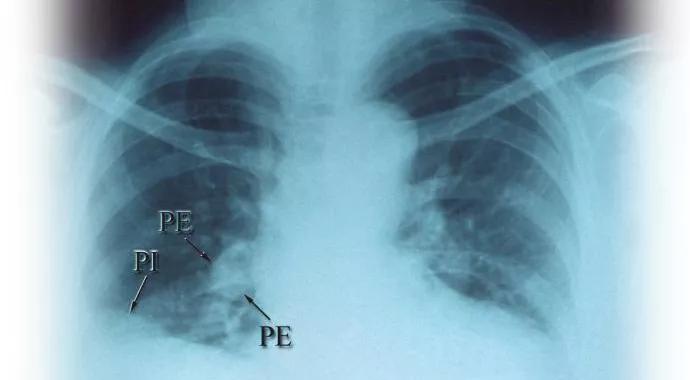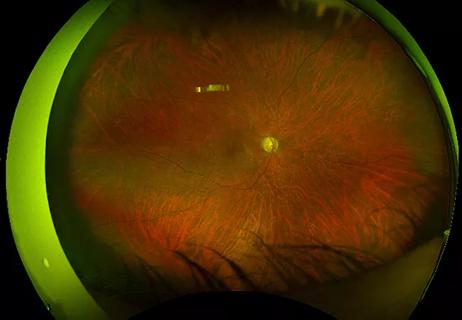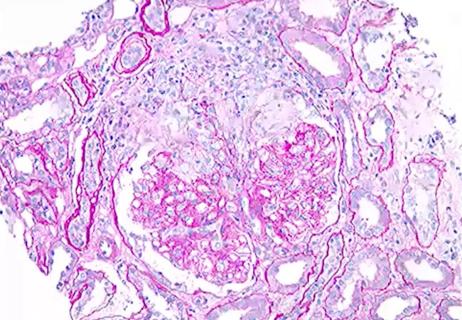Use a low threshold for screening GPA/MPA/EGPA patients

Advertisement
Cleveland Clinic is a non-profit academic medical center. Advertising on our site helps support our mission. We do not endorse non-Cleveland Clinic products or services. Policy
A 60-year-old man with granulomatosis with polyangiitis (Wegener’s) (GPA) experienced a relapse one month ago with sinus disease, purpura and glomerulonephritis, for which he was treated with prednisone and rituximab. He returns to clinic today and is found to have new bilateral lower extremity swelling. His medications include prednisone 60 mg daily, amlodipine 10 mg daily and trimethoprim/sulfamethoxazole 160 mg/800 mg three times a week. Labs include creatinine 1.3 mg/dL and urinalysis with 3+ protein, 1+ blood and no RBC casts. What steps should you take regarding his leg swelling?
A 45-year-old woman with well-established GPA diagnosed three years ago comes to your clinic with a swollen right leg. She was last seen one month ago, at which time she was in remission on azathioprine. She describes a recent four-hour car trip to take her son to college. A venous duplex ultrasound confirms a deep venous thrombosis (DVT). What other evaluations do you need to perform?
Although it is not obvious, these two patients have a great deal in common in that they both had a DVT, active GPA and other factors in their history that might divert away from consideration of these diagnoses.
For the first patient, there are multiple reasons why he may have bilateral lower extremity swelling, including proteinuria and his use of high-dose glucocorticoids and amlodipine. However, with his recently active GPA, the possibility of a DVT must be considered, so the first step in his care would be an immediate venous duplex ultrasound to assess this possibility.
Advertisement
The second patient presented with unilateral lower extremity edema and was found to have a DVT. Although the recent extended car trip provided a risk factor for the DVT, on further evaluation she was found to have evidence of relapsing GPA with new pulmonary nodules.
These patients highlight the relationship that exists between GPA and venous thrombotic events (VTEs), particularly DVT and pulmonary embolism. This association was first described in conjunction with the Wegener’s Granulomatosis Etanercept Trial, which found a higher rate of VTE compared not only with the general population but also with a high-risk lupus population and a rheumatoid arthritis cohort treated with etanercept.1 Since that time, an increased risk of VTE has been confirmed in other studies, where it was seen not only in GPA but also in microscopic polyangiitis (MPA) and eosinophilic granulomatosis with polyangiitis (Churg-Strauss) (EGPA).2,3 At the current time, the reason for this association between VTE and GPA/MPA/EGPA is unknown and remains under active investigation.
Although VTE should always be considered in a clinically suggestive setting, there is a higher association of these events with active disease. For this reason, we should be particularly watchful for any symptoms or signs that may suggest a VTE around the time of a new diagnosis or relapse of GPA/MPA/EGPA. These presentations can commonly include not only unilateral leg swelling but also bilateral leg swelling, as was seen in Case 1, as well as features that might suggest a pulmonary embolism.
Advertisement
This association with active disease should be viewed from the other direction as well, such that a patient with GPA/MPA/EGPA who is found to have a VTE should be assessed for evidence of active disease, as was done in Case 2, where relapsing disease was indeed discovered.
The management of VTE can be complicated in patients with active or recently active GPA/MPA/EGPA if bleeding events such as pulmonary hemorrhage or severe epistaxis are present. Particularly in the setting of recent pulmonary hemorrhage, the risk of anticoagulation may be substantial, often warranting placement of an inferior vena cava filter as an alternative protective measure.
Awareness of VTE risk is essential in patients with GPA/MPA/EGPA and particularly in those with active or recently active disease. To date, there have been no data supporting a role for therapeutic anticoagulation in such patients who do not have VTE, as this carries its own risks. However, vigorous use of other preventive strategies is critical. This includes standard preventive measures in hospitalized patients and patient education about DVT prevention in the setting of car or airplane travel. Employing a low threshold for screening in any GPA/MPA/EGPA patients with signs or symptoms of VTE can detect these important events that can be associated with morbidity and even mortality.
Advertisement
Dr. Langford is Director of the Center for Vasculitis Care and Research as well as Vice Chair for Research, Department of Rheumatic and Immunologic Diseases.
Advertisement
Advertisement

Evidence-based therapies, monitoring, prevention and more

Holistic approach is necessary to ensure a correct diagnosis

Knowing the affected organs and vessels can help in identifying cause

When to consider the possibility of pulmonary artery involvement

When GCA initially presents without cranial symptoms

Relapses are frequent even with long periods of remission

Multidisciplinary management resolves complex case

Raising awareness of a common manifestation